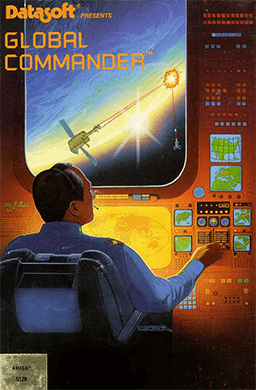Global Commander
| Global Commander | |
|---|---|
 | |
| Developer(s) | Martech |
| Publisher(s) | Martech, Datasoft |
| Platform(s) | Amiga, Amstrad CPC, Atari ST, Commodore 64, MS-DOS, ZX Spectrum |
| Release date(s) |
|
| Genre(s) | Real-time strategy |
| Mode(s) | Single-player |
Global Commander (known as The Armageddon Man in Europe) is a computer game developed by Martech in 1987 for the Amiga, Amstrad CPC, Atari ST, Commodore 64, MS-DOS and ZX Spectrum.
Gameplay
The player's goal is to become the successful Global Commander by preventing conflict between the 16 member countries of the U.N.N. These nations possess varying levels of technological capabilities, natural resources, and missile technology. The player's nation has laser-defense satellites to knock down missile attacks from one nation to another, as well as three "Big Bird" Reconnaissance Satellites that can detect military activity. When one nation requests or demands something from another nation, the player receives a warning; the player can also scan radio frequencies for coded messages.[1]
Reception
Computer Gaming World criticized Global Commander's music and lack of a save option. It concluded "the game can be entertaining, but overall, the inconveniences may outweigh the advantages".[2] A 1992 survey in the magazine of wargames with modern settings gave the game two stars out of five, stating that "it bears little resemblance to reality and has limited entertainment value".[3] The game was reviewed in 1988 in Dragon #140 by Hartley, Patricia, and Kirk Lesser in "The Role of Computers" column. The reviewers gave the game 4 out of 5 stars.[1]
References
- 1 2 Lesser, Hartley; Lesser, Patricia; Lesser, Kirk (December 1988). "The Role of Computers". Dragon (140): 74–79.
- ↑ Brooks, M. Evan (September 1988). "Global Commander" (PDF). Computer Gaming World. No. 51. p. 23. Retrieved 23 April 2016.
- ↑ Brooks, M. Evan (June 1992). "The Modern Games: 1950 - 2000". Computer Gaming World. p. 120. Retrieved 24 November 2013.